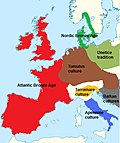 | and weapons. The Lusatian culture developed as the preceding Trzciniec culture experienced influences from the Tumulus culture of the Middle Bronze Age... 13 KB (1,258 words) - 15:51, 5 May 2024 |
 | burial 6, Late Bronze Age, Srubnaya culture. Trzciniec culture Tumulus culture Nordic Bronze Age Unetice culture "We observed a main cluster of Sintashta... 16 KB (1,622 words) - 21:21, 22 March 2024 |
 | metallurgical traditions. It is closely related to the Trzciniec culture. The Komarov culture is usually associated with the evolution of the Proto-Slavs... 2 KB (183 words) - 17:23, 10 October 2023 |
Trzciniec may refer to the following places: Trzciniec, Gmina Białe Błota in Kuyavian-Pomeranian Voivodeship (north-central Poland) Trzciniec, Gmina Sicienko... 1 KB (187 words) - 16:22, 26 August 2017 |
 | cremations begin to be found in the Proto-Lusatian and Trzciniec culture. The Urnfield culture was located in an area stretching from western Hungary... 107 KB (11,288 words) - 14:06, 20 April 2024 |
 | Bronze- and Iron-Age Poland (section Trzciniec culture) (pre-Lusatian) Tumulus culture and the Trzciniec culture. Characteristic of the remaining bronze periods were the Urnfield cultures; within their range skeletal... 41 KB (5,495 words) - 18:44, 18 January 2024 |
 | The archaeological Neman culture (German: Memel-Kultur) existed from about 5100 to the 3rd millennium BC, starting in the Mesolithic and continued into... 7 KB (634 words) - 03:07, 8 April 2024 |
 | Early Slavs (section Culture-historical viewpoint) the ethnogenesis of Slavic people is the Trzciniec culture from about 1700 to 1200 BC. The Milograd culture hypothesis posits that the pre-Proto-Slavs... 127 KB (15,621 words) - 21:06, 19 April 2024 |
on the territories of contemporary Belarus, Russia, and Ukraine. Clan cultures of the Stone Age and Bronze Age, up to the Late Antiquity period of the... 41 KB (1,356 words) - 08:54, 19 April 2024 |
 | Maykop culture (Russian: майкоп, [mɐjˈkop], scientific transliteration: Majkop,), c. 3700 BC–3000 BC, is a major Bronze Age archaeological culture in the... 22 KB (2,637 words) - 10:03, 11 April 2024 |
 | The Abashevo culture (Russian: Абашевская культура, romanized: Abashevskaya kul'tura) is a late Middle Bronze Age archaeological culture, ca. 2200–1850... 25 KB (2,936 words) - 17:15, 15 April 2024 |
 | The Hallstatt culture was the predominant Western and Central European archaeological culture of the Late Bronze Age (Hallstatt A, Hallstatt B) from the... 76 KB (8,518 words) - 22:15, 5 May 2024 |
 | evolution of different cultures developed to the existence of Unetice culture that affected the existence of Trzciniec culture. In the next periods since... 57 KB (6,651 words) - 19:36, 5 May 2024 |
 | The Andronovo culture is a collection of similar local Late Bronze Age cultures that flourished c. 2000–1150 BC, spanning from the southern Urals to the... 63 KB (7,041 words) - 15:09, 4 May 2024 |
 | Kurgan hypothesis (redirect from Kurgan culture) prehistoric cultures, including the Yamnaya (or Pit Grave) culture and its predecessors. In the 2000s, David Anthony instead used the core Yamnaya culture and... 34 KB (3,825 words) - 14:41, 30 April 2024 |
Afanasievo culture, or Afanasevo culture (Afanasevan culture) (Russian: Афанасьевская культура Afanas'yevskaya kul'tura), is an early archaeological culture of... 63 KB (6,146 words) - 09:23, 2 May 2024 |
 | Indus Valley Civilisation (redirect from Indus Valley Culture) and later cultures called Early Harappan and Late Harappan in the same area. The early Harappan cultures were populated from Neolithic cultures, the earliest... 187 KB (21,237 words) - 20:23, 5 May 2024 |
The Tagar culture was a Bronze Age Saka archeological culture which flourished between the 8th and 1st centuries BC in South Siberia (Republic of Khakassia... 20 KB (1,924 words) - 01:17, 21 April 2024 |
 | The Kura–Araxes culture (also named Kur–Araz culture, Mtkvari–Araxes culture, Early Transcaucasian culture) was an archaeological culture that existed from... 35 KB (3,913 words) - 09:27, 2 May 2024 |
 | The Globular Amphora culture (GAC, German: Kugelamphoren-Kultur (KAK); c. 3400–2800 BC, is an archaeological culture in Central Europe. Marija Gimbutas... 9 KB (1,075 words) - 13:23, 20 April 2024 |
 | The Tumulus culture (German: Hügelgräberkultur) was the dominant material culture in Central Europe during the Middle Bronze Age (c. 1600 to 1300 BC)... 24 KB (2,074 words) - 10:23, 25 April 2024 |








